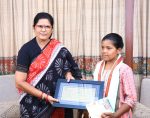This is the inspiring story of Sr. Valsa John, a Catholic nun who worked among the Santal tribals of Jharkhand for more than 15 years — first as a schoolteacher and then as a human rights activist—until her brutal murder on November 15, 2011.
It provides an insider’s view of the people’s resistance movement led by Sr. John, a member of the Sisters of Charity of Jesus and Mary, against coal mining and displacement in the Amrapara block of Pakur district, Jharkhand.
The funeral is over and the voice is silenced! On November 16, 2011, Sr. Valsa John’s body was interred in a public cemetery at Vijaypur, Dumka district, Jharkhand. But only her body has been interred. Her spirit will live forever in the hearts of the poor and the oppressed. It will live in the hearts of all the people of goodwill. Let us remember that she has shed her blood on the eleventh birth anniversary of Jharkhand. Her death proclaims that Jharkhand needs the blood of martyrs to fulfill the basic human rights of tribals in this young State.
Proclaiming and struggling for this fulfillment had been Sr. Valsa’s public life for over fifteen years. Whether working among the Dalits of Patna or the Adivasis of Santal Parganas, she had carried out a valiant struggle for a life of dignity and justice. Her determination to be part of the oppressed masses had not wavered even once during those long years.
The greatest indignity and injustice to the tribals of India has been to uproot them from their ancestral land. After the land has been snatched away, violence has followed and the tribals have descended into an abyss of criminalization and dehumanization.
In our simple language, this is termed as “displacement.” Sr. Valsa foresaw all these evils and mobilized the masses, so that their voices could be heard and they could get justice. She dedicated the last fifteen years of her life to the cause of the displaced and the uprooted.
As a teacher in Bihar and Jharkhand
SR. John was born on February 19, 1958, in Edapalli, a village near Kochi, Kerala. She was the youngest child in a family of six brothers and sisters. She received abundant love from everyone around her. As a young girl, Valsa was so full of love that she wanted to share it with those who needed it most.
Despite being the youngest in her family, she became the “didi” or elder sister for the poor and the exploited. But how could her large family part with their youngest? So they educated her and she became a teacher.
As a teacher, she began reading the stories of heroes and heroines in real life, so that she can teach her children about them. In the process, she was deeply moved by the lives of two missionary sisters working in northern India—one in the jungles of Jharkhand and the other among the Gonds of Madhya Pradesh. In 1984, Valsa joined the Sisters of Charity of Jesus and Mary, with the intention of working among the poor.
After her initial training, she was appointed in a school at Daltonganj, Jharkhand. Here, she began observing the poor much more closely, and a burning desire to be committed radically to the cause of the poor was strengthened within her. She then went for teachers’ training and taught briefly in Himachal Pradesh.
Thereafter, her commitment to radical social reform gradually came to the forefront. She went to Khagaul, Bihar, for a guided experience among the Dalits. Here, “immersion” and “participation” were not mere words but acquired experiential meaning. Sr. John soon immersed herself in the daily struggles of the Dalits.
Frugality became a lifelong companion for her. This experiential knowledge of hunger and poverty became such an integral part of her nature that she was able to relate to the powerlessness of the oppressed and marginalized people, throughout her life.
In 1993, Sr. Valsa moved to Kodma, Sahibganj district, Jharkhand, to work among the Santal tribals. Here, she was welcomed by the Sona Santal Samaj Samiti (forum for the golden Santal society) , an organization formed after the martyrdom of Fr. Anthony Murmu and fourteen others at Banjhi, Sahibganj, in 1985.
Sr. Valsa began walking to the villages, meeting women and going to the hills with them. She endeared herself to the women of that area by gradually learning their language, customs and folk dances. She also began organizing the women systematically, enabling them to participate in the traditional village councils and other meetings (in which men usually participated).
It was at this time that the tribals all over India were demanding legal recognition of their traditional self-governance system. Sr. Valsa mobilized the women by making them understand the reasons behind this demand. She worked in the Sona Santal Samaj Samiti and among the women of that area for two years, until she left Kodma in 1995.
Thereafter, Sr. Valsa was appointed as a full-time teacher in a convent school at Jiapani near Amrapara, Pakur district, Jharkhand. This was a sad time for her because her heart was with the exploited women and their struggles in Sahibganj. As a full-time teacher in Pakur, she had to stay in the school premises until 4.00 pm.
But Sr. Valsa refused to rest; she began touring the nearby villages in the evenings and during holidays. She would meet the traditional leaders and interact with them, mobilizing their support for the recognition of the local self-governance system. An important side-effect of her touring of the villages was an increase in the number of students in the school. She often went alone to the villages and came back after the sun had set.
As a human rights activist in Pakur, Jharkhand
It was during one of these walking tours that she noticed a camp of the Geological Survey of India, near a village called Baromasia. When she enquired about its purpose, the officers thought that she might help them in persuading the people to part with their land for mining. So they revealed the real intention of their camp. Sr. Valsa acquired more information and realized that the Santals would be displaced on a massive scale if the project for coal mining came through.
History teaches us that tribals have often been the victims of development: 40 percent of all the displaced have been tribals and the promised rehabilitation has seldom been implemented. Sr. Valsa knew these statistics; so she understood the repercussions of the coal mining project. She also understood the power of private companies when assisted by the administration, within the context of the new liberalized economy.
At this juncture, Sr. Valsa requested her superiors to relieve her from the school. The superiors gladly granted her request, knowing her earnestness and the need of the people. She moved to Pachuwara (Pachubera) village in 1998. She began informing the people about the actual intentions of the government. They listened to her and realized that they were being duped.
The Geological Survey of India had casually told the villagers that they were doing some governmental work. None of the officials had told them about the impending displacement and the procedures for land acquisition. No rehabilitation packages had been announced.
It was only after Sr. Valsa began unifying the villagers that all the facts emerged. Briefly stated, the Eastern Mines Trading Agency in a joint venture with the Punjab Electricity Board had acquired the coal block of that area, and the extracted coal was to be transported to Punjab for electricity production. This joint venture was known as PANEM Coal Mines Ltd.
Sr. Valsa began mobilizing the people of Pachuwara, Alubera and other adjoining villages to resist the mining project. The villagers first deliberated in hushed tones and then in public. As always, the people realized that only an organization of their own would help them in the hour of need. So they had to organize themselves.
During this time, Sr. Valsa stood by them, inspired them and animated them. The final outcome was the formation of a Samiti or organization called the “Rajmahal Pahar Bachao Andolan” (RPBA) or Rajmahal Hills Protection Movement.
The name of this Samiti recalled a song sung by Fr. Anthony Murmu, another martyr who had been shot to death along with fourteen others by the Bihar police on April 19, 1985, during a peaceful protest at Banjhi, Sahibganj. Fr. Anthony would often sing: “Our God is as rock-steady as the Rajmahal Hills.”
Traditionally, the Rajmahal Hills had protected the Santals, provided them with livelihood and fired their imagination. Now these hills were in peril! These hills, that symbolized the compassion and majesty of God, were going to be destroyed! The tribals realized that resistance was the only way out for them and their children.
Methodology of the resistance movement
The methodology of this resistance movement may be broadly placed under these four categories: memorandums, blockade, networking and self-empowerment through welfare measures.
• The people began by writing memorandums to the district authorities and their electoral representatives. This was also a learning process for them. They began understanding the constitutional provisions that provided for the protection of the tribal people in India: the Fifth Schedule of the Indian Constitution, the Santhal Parganas Tenancy (SPT) Act of 1949, the Panchayat Extension to the Scheduled Areas (PESA) Act of 1996 and the historic “Samata Judgment” of the Supreme Court of 1997. These memorandums by the people went unanswered.
• Side-by-side with the writing of memorandums, a blockade also began. The villagers set up barriers at various junctures in Amrapara block to prevent strangers from entering the area. Men, women, the youth and even the children manned these barriers for twentyfour hours at a stretch. It is significant that this blockade continued for six years.
• As news about the resistance movement spread through networking, many organisations and civil society activists came forward to help the people. The movement began attracting the national limelight.
• Besides resisting the coal mining project, it was also understood that the agricultural lands needed to be utilised fruitfully. So Sr. Valsa began introducing the people to new and innovative techniques of land cultivation. This process of self-empowerment through welfare measures was seen as one of the main planks of the alternative development process against coal mining.
It is worth noting that Sr. Valsa sacrificed the comforts of convent life and remained with the villagers throughout. She ate with them and walked the hills with them. Sometimes she even slept under the trees and on riverbeds along with them, after participating in nightlong deliberations. Her intuitive power helped her to understand the way tribals moved, organised and resisted. So while she did lead the movement, the traditional leadership was also there on the forefront with her. It was the traditional leaders who negotiated and guided the movement at some stages.
Response of the Company and the Administration
THE company set up an office in the nearby market town of Amrapara and soon had the civil administration at its beck and call. Many Santals from far and near used to visit Amrapara regularly since they depended on the market town for their household provisions. The middlemen of the company started scouting around the town and managed to recruit a Santal youth.
Thereafter, a local geology graduate of the Santal tribe, named James Murmu, who was in the employ of the company, was transferred to Amrapara. He began providing money and liquor to the Santal youth of the nearby villages. Many of them were persuaded to join the company and were put on its payroll. Their job was to convince the people to part with their land.
They did this by arguing that the land actually belonged to the government and that compensation would not be offered if the people continued their resistance. So it was in their best interest to stop the fight and receive their compensation.
This cunning ploy worked and the unity of the people began to show signs of fragmenting. The unemployed youth of that area were the most vulnerable to offers of money and other allurements. Hence, the resistance movement began breaking apart.
A time came when the social fabric of these harmonious tribal villages had been torn apart irreversibly. The tribals started fighting among themselves, while the company watched and bided its time. The years between 2001 and 2004 witnessed tremendous tension in the villages.
On another front, the administration began filing cases against the leaders of the movement. Some close associates of Sr. John, like Joseph Soren and the Pargana (chieftain) of a nearby area, were picked up from the market and jailed. While the Pargana was released after six months, Joseph remained in jail for two years.
Most of the cases filed were non-bailable in nature. Sr. Valsa alone had seven cases foisted on her. The police began arresting people whenever they went to the market. As a result, life became unbearable for ordinary people. They were unable to go to the market for fear of the police or visit their children in hostels.
The households of the movement leaders became divided and children began turning against their parents. There were cases of children running away to Delhi and Punjab. Although Sr. Valsa stood by the people and consoled them, it was painful to see the gradual decline of the movement. Many men and women went surreptitiously to the company office and received their compensation.
MoU between PANEM Coal Mines Ltd. and RPBA Samiti
AT this stage, Sr. Valsa contemplated various ways to reach out to the demoralized people. She deliberated constantly with her supporters, including the journalist, Saji Joseph, who championed the cause of the tribals. She spent long hours at night holding discussions with the people of various villages.
After prolonged consultation, the Samiti decided to approach the High Court in the hope that it would uphold the constitutional provisions. To their shock and dismay, the High Court ruled in favor of the company and government. The Supreme Court was then approached, which recommended an out-of-court settlement.
Hence, a Memorandum of Understanding (MoU) was signed between the company and the Samiti in 2006. The following points will be relevant to understand the innovative significance of the MoU:
• The company was made to acknowledge that the land belonged to the people and that the company would return it to the rightful owners after the coal had been extracted. Furthermore, the land would be filled and made cultivable before being returned.
• Until the return of the land, the company would pay crop compensation of Rs 6000 per acre per year to the owners of the land. They would also be paid Rs 10,000 per acre as share of the profits earned from the coal.
• The people would not be displaced. If need be, they would be resettled in the vicinity. Concrete houses would be built for each household, including separate houses for widows and divorced single women.
• The company would provide free education to the children of the project-affected people. It would also open a school and a hospital for the project-affected people. The company gave an undertaking to comply with all the conditions within a year.
In 2006, PANEM Coal Mines Ltd. started its mining operations in Amrapara. A Monitoring Committee was set up; it consisted of two representatives from each village, two representatives from the Samiti, three representatives from the traditional leadership and three representatives from the company.
After 2006, Sr. Valsa concerned herself with the implementation of the MoU in letter and spirit. A dispensary was built and made operational until the hospital could be constructed; she made sure that the ambulance reached needy patients on time. Sr. Valsa also oversaw the running of a temporary school that had been built. Above all, she made sure that the village women participated and organised themselves.
The MoU was revolutionary in nature because it influenced the resettlement and rehabilitation (R&R) policy of the government at the Central and State levels. Sr. Valsa played a crucial role in the MoU, first by providing valuable inputs and then by ensuring that it was operational. In the process, however, she gained many friends as well as enemies.
Decline of the Resistance Movement
AS the coal mining started, life in this remote area of Jharkhand began changing at a rapid pace. Huge amounts of money began flowing to the people and gave rise to new ambitions. The tribal people, who had never seen such free flow of money before, now aspired to become more powerful. The Samiti members already had some power; now they wanted more money to hold sway over their community.
The temptation to become rich faster made them sacrifice the very ideals that they had learned during their long struggle. The resistance movement had taught them to honor their own simple lifestyle and abhor greed, but now they began succumbing to a new lust for power and money. Middlemen working for the company, government servants and aspiring politicians began providing different forms of allurement to the youth of the Samiti. The violence of the mining industry also began affecting their character and they descended into an abyss of criminalization.
Even as the movement declined, Sr. John’s moral strength and leadership continued to uphold many people. Her single-minded supervision of the Monitoring Committee’s activities became a hindrance to her opponents and she was seen as a stumbling-block to their evil aspirations. So they began propagating false accusations against her.
They got a shot in the arm when she went for three months to Kerala to be at the side of her brother, who was ailing from cancer. They tried to demoralize the people by spreading the rumor that Sr. Valsa had gone away permanently and then formed a Samiti of their own. They announced openly that Sr. Valsa would not be allowed to return to Amrapara.
Sr. John defied her opponents and returned to Pachuwara on November 7, 2011. A week later, on November 15, 2011, she was brutally hacked to death by a mob of forty armed men.
The immediate spark for Sr. Valsa’s murder was provided by the rape of a girl working with her. Some days earlier, Surajmuni had been picked up at the Alubera weekly market by a group of young men and gang-raped that night. The next day, her parents had reported the rape at the local police station and tried to file an FIR, but the police had refused and chased them away.
Thereafter, the parents had approached Sr. Valsa for help. On her advice, the victim and her parents had gone to the police station again. They had been rudely told to settle the case out-of-court and accept monetary compensation. But the rape victim had refused to compromise and demanded justice. At this juncture, Sr. Valsa had intervened and managed to get an appointment for the rape victim with the District Collector on November 16, 2011.
For the criminalized youth of Alubera, this was probably the last straw. Their anger flared as they realized that Sr. Valsa had become a hindrance not only to their greedy designs, but also to their easy access to women. Her brutal murder was the culmination of a process of dehumanization that had been set into motion by the company and the violent atmosphere of the mining area.
Sr. Valsa John stood for the rights of the victim all her life and she finally paid for it with her life. Her voice may have been silenced, but her silent presence will always remain in the hearts of all those who struggle for and with the oppressed masses of India.
(The article first appeared in the Mainstream Weekly on December 9, 2011)










